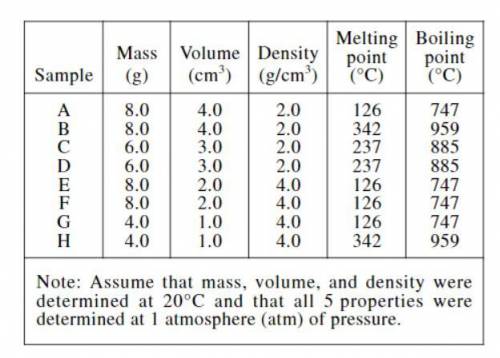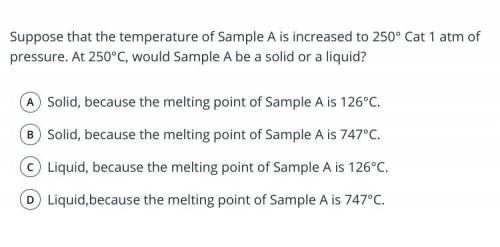
Chemistry, 08.12.2020 01:50 23ricorvan
A teacher provided the table below to the students in a science class. The table gives 5 properties for each of Samples A−H. The students were told to assume that each sample is a completely solid cube composed of a single hypothetical pure substance.
The teacher asked each of 4 students to explain how these data could be used to predict which samples are composed of the same substance.
Student 1
If 2 samples have the same values for all 5 properties, they are composed of the same substance. If 2 samples have different values for any of the 5 properties, they are composed of different substances.
Student 2
If 2 samples have the same values for any 3 or more of the 5 properties, they are composed of the same substance. If 2 samples have the same values for fewer than 3 of the 5 properties, they are composed of different substances.
Student 3
If 2 samples have the same mass, volume, and density, they are composed of the same substance. If 2 samples have different values for any of these 3 properties, they are composed of different substances. Neither melting point nor boiling point, by itself, can distinguish between substances.
Student 4
If 2 samples have the same density, melting point, and boiling point, they are composed of the same substance. If 2 samples have different values for any of these 3 proper-ties, they are composed of different substances. Neither mass nor volume, by itself, can distinguish between substances.



Answers: 2
Another question on Chemistry

Chemistry, 22.06.2019 08:30
The characteristic of two different types of reactions are shown below. reaction a: electrons are gained by the atoms of an element. reaction b: protons are lost by the atom of and element. which statement is true about the atoms of the elements that participate in the two reactions? a: their identity changes in both reaction a and b. b: their identity changes in reaction a but not b. c: their identity changes in reaction b but not a. d: their identity remains the same.
Answers: 1

Chemistry, 22.06.2019 12:10
|using the periodic tablewarm-upuse the periodic table in the tools bar to answer the following questions.what elemental classification does oxygen belongto? done
Answers: 3

Chemistry, 22.06.2019 13:50
Read the chemical equation. 2c2h2 + 5o2 → 4co2 + 2h2o which of the following statements would be correct if one mole of c2h2 was used in this reaction? one mole of oxygen was used in this reaction. five moles of oxygen were used in this reaction. four moles of carbon dioxide were produced from this reaction. two moles of carbon dioxide were produced from this reaction.
Answers: 3

You know the right answer?
A teacher provided the table below to the students in a science class. The table gives 5 properties...
Questions

Social Studies, 08.07.2019 20:00

Mathematics, 08.07.2019 20:00

Computers and Technology, 08.07.2019 20:00

Arts, 08.07.2019 20:00


Chemistry, 08.07.2019 20:00


Mathematics, 08.07.2019 20:00

Biology, 08.07.2019 20:00

Mathematics, 08.07.2019 20:00

English, 08.07.2019 20:00


Mathematics, 08.07.2019 20:00



English, 08.07.2019 20:00


Geography, 08.07.2019 20:00





